
Wine Culture and Information since 2002 - Volume 22
 Wine Culture and Information since 2002 - Volume 22 |
|
Contrasts of Torgiano Bianco and Delle Venezie Pinot GrigioTrebbiano Toscano and Pinot Grigio compared in the glasses of this month's tasting by contrast. A white from Umbria and one from Veneto different and distant in every aspect. |
|
Trebbiano Toscano is one of the most common white berried varieties of central Italy, also found in other areas of the country. Used in many wines with Denominazione d'Origine Controllata (Denomination of Controlled Origin, DOC) Trebbiano Toscano is – in the majority of cases – blended with other varieties, rarely used alone. Although the term trebbiano identifies many varieties found in Italy – so much so that they are sometimes considered as grapes belonging to the trebbiani family – in reality, in the majority of cases, these varieties have no similarities, including genetic ones, such as to consider them members of a single family. As is widely known, the term trebbiano derives from a quotation found in the famous Naturalis Historia by Pliny the Elder, referring to vinum trebulanum. The term is believed to derive from the Latin adjective trebulanus, which in turn derives from trebula, which translates into “farmhouse”. With the name “trebbiano” we therefore mean the grapes and wines made in a farm, that is, of the local place, in other words “of the village”. Pinot Grigio (Pinot Gris) has a very different history and origin. Belonging to the broad category of the so-called international varieties, that is virtually cultivated in every wine-producing country in the world, it has its homeland in France. Originally from Burgundy, Pinot Grigio is the result of a genetic mutation of Pinot Noir which took place many centuries ago and which also led to a change in the color of the skin. It must in fact be said that Pinot Grigio berries have a “grey-pink” color, therefore in between white and red berried grapes. As for the name, the French term pinot derives from the shape of the bunch which would resemble a small pine cone. Pinot Grigio is pretty versatile in enological terms, in particular the appearance of its wines. The color of the grapes, in fact, depending on how they are vinified – specifically, allowing or excluding the maceration of the must with the skins – take on coppery or “white” colors.
|
|
Torgiano has been the first winegrowing area in Umbria that – in the modern era of wine – has become known and famous nationally and internationally, especially for red wines. Furthermore, the red reserve style has been the first Umbrian wine to obtain the recognition of the Denominazione d'Origine Controllata e Garantita (Denomination of Controlled and Guaranteed Origin, DOCG). In this important wine-producing territory of Umbria, a few kilometers south from Perugia, has been carried out an extensive experimental activity, introducing many varieties, including international ones, which today are part of the “Torgiano” denomination. In this territory are produced white and red wines, as well as sparkling wines, rosé and “Vin Santo”, all recognized as Denominazione d'Origine Controllata (Denomination of Controlled Origin, DOC), whereas the red reserve style is the only one to be recognized as DOCG. Among the many wines provided for the Torgiano DOC production disciplinary, the white style is the best known and most recognizable one, a wine that undeniably recalls the history and tradition of this land. Before the latest modifications made to the Torgiano Bianco disciplinary, Trebbiano Toscano – a variety widely found in Umbria and central Italy – represented the primary quota with no less than half. The current disciplinary instead provides for a quota between 20 and 70%, while the remainder must be made up of non-aromatic white grape varieties allowed for cultivation in Umbria. It is therefore difficult to define a “characteristic” composition of Torgiano Bianco, as its production can include a significant number of varieties, both native to Umbria, Italy and international ones. The fermentation and aging of Torgiano Bianco is usually carried out in inert containers – steel or cement tanks – however there are cases in which producers make use of wood. Torgiano Bianco, regardless of its composition, should however express a character of crispness and which sees acidity its primary expression, a characteristic – in fact – which is often typical of wines produced with Trebbiano Toscano.
|
||||
|
The Denominazione d'Origine Controllata “Delle Venezie”, of recent creation, extends over a very large territory and covers three regions, that is those which are historically called “Tre Venezie” or Triveneto, specifically Veneto, the province of Trento and Friuli-Venezia Giulia. Given the extension of the denomination, the “Delle Venezie” can also be referred to by the equivalent name in Slovenian language, that is “Beneških Okolišev”. The most representative and identifying wine of the appellation certainly is Pinot Grigio, however the production disciplinary also provides for the use of other white berried varieties as well. The denomination “Delle Venezie” includes Pinot Grigio, Pinot Grigio Rosato or Ramato wines, also as slightly sparkling style; Pinot Grigio, Pinot Grigio Rosato or Ramato Spumante and “Delle Venezie Bianco”. In the latter wine, can also be used Chardonnay, Pinot Bianco, Müller Thurgau, Garganega, Verduzzo Friulano, Verduzzo Trevigiano and Friulano, alone or together, for a minimum of 50%. Any remaining part must be made up of white grape varieties allowed for cultivation in the Autonomous Province of Trento and in the Friuli Venezia-Giulia and Veneto Regions. The variety, and therefore the wine, which most distinguishes and identifies this appellation is Pinot Grigio, in the majority of cases vinified as still white wine. The presence of this variety in these lands has now a long history of decades, the result – not least – of the experimentation activities that took place from the end of the 1800s and in the 1900s. Among all the varieties introduced here, Pinot Grigio is the one that, over the course of time, has shown a better adaptability and expression in this territory, becoming – starting from the last twenty years of the last century – a successful enological phenomenon at an international level. Delle Venezie Pinot Grigio, the wine we will examine in our tasting by contrast, is produced, according to the production disciplinary, with at least 85% of the homonymous variety. Any remaining part can be completed with the grapes used for “Delle Venezie Bianco”. The dominant style, as already mentioned, is still white, generally fermented and aged in inert containers, such as steel or cement tanks.
|
It has finally come the time to prepare this month's tasting by contrast, starting with the purchase of the two wines we will pour into the glasses. The bottles of these two denominations are quite easy to find in shops, given their large production and distribution. However, the certainty of the composition of the two wines is quite difficult, as – in both cases – different varieties can contribute to their production, in particular in Torgiano Bianco. As already mentioned, the production disciplinary of this Umbrian wine, over the years, has undergone substantial changes in its composition and Trebbiano Toscano – once being the dominant grape – can now be present in a minimum quantity of 20% . The Torgiano Bianco we will pour into our glass, on the other hand, must be mainly made of Trebbiano Toscano, for at least 50%, in addition to Grechetto. As for Delle Venezie Pinot Grigio, despite its disciplinary provides for the minimum presence of the homonymous grape for 85%, this wine is usually produced with 100% Pinot Grigio. The style we will examine is white, that is produced without maceration of the skins in the must. For both wines we will choose the most recent vintage and will be poured into their respective glasses at a temperature of 10 °C. (50 °F) As usual, we will start the evaluation of wines from the analysis of their appearance, that is how they appear to the eye in terms of color and transparency. The first wine we will examine is Torgiano Bianco, therefore, after having tilted its glass over a white surface – a sheet of paper is enough – let's observe the base, at the point of maximum thickness of the wine. The color which can be seen is brilliant straw yellow and, by placing an object in contrast between the glass and the white surface, we can observe a very high transparency. Let's now pay our attention towards the opening of the glass, where the thickness of the wine is thinner: the nuance of Torgiano Bianco is greenish yellow with straw yellow hues. Let's now pass to the evaluation of the appearance of Delle Venezie Pinot Grigio, by observing the base of the glass. The color of this wine is intense straw yellow, probably darker than Torgiano Bianco. Also in this case, transparency is very high. The nuance of Delle Venezie Pinot Grigio, observed at the edge towards the opening of the glass, reveals a straw yellow color tending towards greenish. The olfactory profiles of Torgiano Bianco and Delle Venezie Pinot Grigio are characterized by substantial differences, despite the fact in both it is possible to perceive white and yellow flowers as well as white and yellow pulp fruits. The olfactory profile of Torgiano Bianco – in the composition we have chosen for this month's tasting – is strongly determined by Trebbiano Toscano, a variety often defined as “neutral” or “not very expressive” according to the nature of its aromas. Although this partially corresponds to the truth, Trebbiano Toscano however offers aromas to the nose which make it recognizable when it is used in a wine. In particular, it is possible to recognize hawthorn and broom, as well as apple, pear, plum and an evident hint of almond. To this is added the character of Grechetto, typically recognizable by the aromas of hazelnut and citrus fruits. Delle Venezie Pinot Grigio offers a completely different olfactory profile and, in addition to the scent of broom and acacia, in its wines can also be perceived sensations recalling white and yellow pulp fruit, in particular apple, pear, pineapple, banana, peach, lemon, grapefruit and hazelnut. Let's continue our tasting by contrast and proceed with the evaluation of the olfactory profiles of the two wines. The first one we will examine, as in the previous phase, is Torgiano Bianco. Let's hold the glass in vertical position and, without swirling, do the first smell in order to evaluate the opening of the wine, that is its identifying aromas, often also defined as first nose. From the glass of Torgiano Bianco we can immediately perceive intense and clean aromas of apple, plum and hawthorn, to which often follow a note in which we recognize almond. After having swirled the glass – operation which favors the development of the other aromas – let's proceed with the second smell. The olfactory profile of the Umbrian wine is completed by broom, pear, peach and hazelnut, the latter typically found in Grechetto. Let's now pass to the evaluation of the opening of Delle Venezie Pinot Grigio, therefore, by holding the glass in vertical position and without swirling, let's proceed with the first smell. We recognize citrus aromas – in particular grapefruit and lemon – as well as apple and broom. After having swirled the glass, the profile of Delle Venezie Pinot Grigio is completed with hawthorn, chamomile, pear, apricot, peach and pineapple. Let's move on to the evaluation of the gustatory profiles of the two wines, starting – as in the previous phases – from Torgiano Bianco. The first gustatory aspect we will examine is the attack, that is how the wine is perceived in the mouth at the first sip. The primary organoleptic sensation perceived is the crispness given by acidity, a quality which is promptly balanced by the effect of alcohol. The structure of Torgiano Bianco can be considered of “medium body”, a characteristic often found in wines produced with Trebbiano Tuscan and Grechetto. In the mouth are perceived flavors of apple, plum and pear, frequently accompanied by a basically bitter sensation in which we recognize almond. Let's now pass to the evaluation of the attack of Delle Venezie Pinot Grigio, let's therefore take a sip of this wine. The differences with the previous one are immediately evident: Pinot Grigio, in which it is clearly perceived the pleasing crispness given by acidity, offers the senses a decidedly “rounder” character, also thanks to the contribution of alcohol. The structure is, like in the previous wine, medium-bodied and in the mouth we perceive flavors of apple, peach, pineapple and grapefruit, frequently lemon as well. We have reached the final phase of this month's tasting by contrast, therefore let's proceed with the evaluation of the final sensations the wines leave in the mouth after swallowing. We will therefore focus on taste-olfactory persistence, that is the amount of time during which – after swallowing – it is possible to continue the perception of gustatory and aromatic sensations. The finish of Torgiano Bianco is persistent and in the mouth we can clearly perceive both the crispness given by acidity and the basically bitter taste of almond, a quality often distinguishing wines made from Trebbiano Toscano and, in some cases, also those produced with Grechetto. Moreover, in the mouth we continue to perceive the flavors of apple, plum, pear and almond. The finish of Delle Venezie Pinot Grigio is equally persistent and in the mouth we continue to perceive the crispness of acidity well supported by a pleasing sensation of roundness. Furthermore, we can continue perceiving the flavors of apple, peach, pineapple and grapefruit. Let's now place the two glasses side by side and proceed with the last smell, first Torgiano Bianco, then Delle Venezie Pinot Grigio: the olfactory differences of the two wines are still different and distant.
|
||||||||
Wines of the Month |
|
|
|
Score legend Prices are to be considered as indicative. Prices may vary according to the country or the shop where wines are bought |
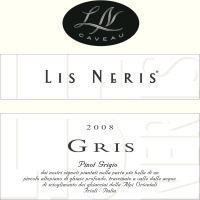
|
|
Friuli Isonzo Pinot Grigio Gris Caveau 2008 |
|
| Lis Neris (Friuli-Venezia Giulia, Italy) | |
 Pinot Grigio Pinot Grigio | |
| Price: € 22.00 | Score: |
 Brilliant golden yellow and nuances of golden yellow, transparent. Brilliant golden yellow and nuances of golden yellow, transparent. Intense, clean, pleasing, refined and elegant, starts with hints of
citron, apple and flint followed by aromas of hawthorn, pear jam, mango,
pineapple, plum, grapefruit, hazelnut, butter, honey, croissant, marzipan
and linden. Intense, clean, pleasing, refined and elegant, starts with hints of
citron, apple and flint followed by aromas of hawthorn, pear jam, mango,
pineapple, plum, grapefruit, hazelnut, butter, honey, croissant, marzipan
and linden.
 Crisp attack and however balanced by alcohol, good body, intense
flavors, pleasing roundness. Crisp attack and however balanced by alcohol, good body, intense
flavors, pleasing roundness.
 Very persistent finish with long flavors of citron, apple and
marzipan. Very persistent finish with long flavors of citron, apple and
marzipan.
 11 months in cask, 4 months in bottle. 11 months in cask, 4 months in bottle. |
|
 Stuffed pasta with fish and mushrooms, Broiled fish, Roasted white meat, Mushroom soups Stuffed pasta with fish and mushrooms, Broiled fish, Roasted white meat, Mushroom soups |
|
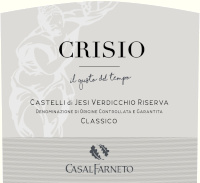
|
|
Castelli di Jesi Verdicchio Riserva Classico Crisio 2018 |
|
| CasalFarneto (Marches, Italy) | |
 Verdicchio Verdicchio | |
| Price: € 15.00 | Score: |
 Intense straw yellow and nuances of golden yellow, very transparent. Intense straw yellow and nuances of golden yellow, very transparent. Intense, clean, pleasing, refined and elegant, starts with hints of
apple, plum and hawthorn followed by aromas of broom, chamomile, pear,
citrus fruits, medlar, peach, pineapple, anise, thyme, honey, almond and
vanilla. Intense, clean, pleasing, refined and elegant, starts with hints of
apple, plum and hawthorn followed by aromas of broom, chamomile, pear,
citrus fruits, medlar, peach, pineapple, anise, thyme, honey, almond and
vanilla.
 Crisp attack and however balanced by alcohol, good body, intense
flavors, pleasing roundness. Crisp attack and however balanced by alcohol, good body, intense
flavors, pleasing roundness.
 Very persistent finish with long flavors of apple, plum and almond. Very persistent finish with long flavors of apple, plum and almond. Half of the wine ferments in barrique. More than 12 months in steel
tanks, at least 12 months in bottle. Half of the wine ferments in barrique. More than 12 months in steel
tanks, at least 12 months in bottle.
|
|
 Stuffed pasta with mushrooms, Stewed fish with mushrooms, Roasted fish, Roasted white meat, Mushroom soups, Cheese Stuffed pasta with mushrooms, Stewed fish with mushrooms, Roasted fish, Roasted white meat, Mushroom soups, Cheese |
|
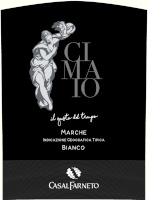
|
|
Cimaio 2016 |
|
| CasalFarneto (Marches, Italy) | |
 Verdicchio Verdicchio | |
| Price: € 10.00 - 500ml | Score: |
 Deep golden yellow and nuances of amber yellow, transparent. Deep golden yellow and nuances of amber yellow, transparent. Intense, clean, pleasing, refined and elegant, starts with hints of
quince, pear and apricot followed by aromas of hawthorn, broom, chamomile,
citron, plum, peach, papaya, melon, pineapple, ginger, honey, saffron and
almond. Intense, clean, pleasing, refined and elegant, starts with hints of
quince, pear and apricot followed by aromas of hawthorn, broom, chamomile,
citron, plum, peach, papaya, melon, pineapple, ginger, honey, saffron and
almond.
 Crisp attack and however balanced by alcohol, full body, intense
flavors, pleasing roundness. Crisp attack and however balanced by alcohol, full body, intense
flavors, pleasing roundness.
 Very persistent finish with long flavors of quince, pear and apricot. Very persistent finish with long flavors of quince, pear and apricot. Half of the wine ages for 6 months in cask. 12 months in bottle. Half of the wine ages for 6 months in cask. 12 months in bottle. |
|
 Fish soups, Stewed white meat, Piquant cheese Fish soups, Stewed white meat, Piquant cheese |
|
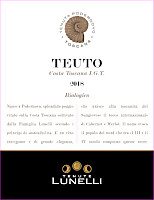
|
|
Teuto 2018 |
|
| Tenuta Podernovo (Tuscany, Italy) | |
 Sangiovese (65%), Merlot (30%), Cabernet Sauvignon (5%) Sangiovese (65%), Merlot (30%), Cabernet Sauvignon (5%) | |
| Price: € 24.00 | Score: |
 Intense ruby red and nuances of garnet red, little transparency. Intense ruby red and nuances of garnet red, little transparency. Intense, clean, pleasing and refined, starts with hints of plum, black
cherry and dried violet followed by aromas of blueberry, black currant,
chocolate, tobacco, cinnamon, pink pepper, vanilla and menthol. Intense, clean, pleasing and refined, starts with hints of plum, black
cherry and dried violet followed by aromas of blueberry, black currant,
chocolate, tobacco, cinnamon, pink pepper, vanilla and menthol.
 Properly tannic attack and however balanced by alcohol, good body,
intense flavors, agreeable. Properly tannic attack and however balanced by alcohol, good body,
intense flavors, agreeable.
 Persistent finish with flavors of black cherry, plum and blueberry. Persistent finish with flavors of black cherry, plum and blueberry. 18 months in cask and barrique, at least 6 months in bottle. 18 months in cask and barrique, at least 6 months in bottle. |
|
 Broiled meat and barbecue, Roasted meat, Stewed meat with mushrooms, Hard cheese Broiled meat and barbecue, Roasted meat, Stewed meat with mushrooms, Hard cheese |
|
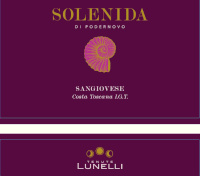
|
|
Solenida 2017 |
|
| Tenuta Podernovo (Tuscany, Italy) | |
 Sangiovese Sangiovese | |
| Price: € 56.00 | Score: |
 Intense ruby red and nuances of garnet red, little transparency. Intense ruby red and nuances of garnet red, little transparency. Intense, clean, pleasing, refined and elegant, starts with hints of
plum, black cherry and dried violet followed by aromas of blackberry,
blueberry, cocoa, tobacco, face powder, licorice, leather, vanilla and
menthol. Intense, clean, pleasing, refined and elegant, starts with hints of
plum, black cherry and dried violet followed by aromas of blackberry,
blueberry, cocoa, tobacco, face powder, licorice, leather, vanilla and
menthol.
 Tannic attack and however balanced by alcohol, full body, intense
flavors, agreeable. Tannic attack and however balanced by alcohol, full body, intense
flavors, agreeable.
 Persistent finish with flavors of plum, black cherry and blackberry. Persistent finish with flavors of plum, black cherry and blackberry. 24 months in cask, 24 months in bottle. 24 months in cask, 24 months in bottle. |
|
 Game, Roasted meat, Stewed and braised meat, Hard cheese Game, Roasted meat, Stewed and braised meat, Hard cheese |
|
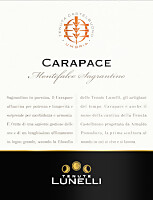
|
|
Montefalco Sagrantino Carapace 2017 |
|
| Tenuta Castelbuono (Umbria, Italy) | |
 Sagrantino Sagrantino | |
| Price: € 33.00 | Score: |
 Intense ruby red and nuances of garnet red, little transparency. Intense ruby red and nuances of garnet red, little transparency. Intense, clean, pleasing, refined and elegant, starts with hints of
blackberry, plum and black cherry followed by aromas of dried violet,
blueberry, chocolate, tobacco, carob, licorice, cigar box, mace, leather,
vanilla and menthol. Intense, clean, pleasing, refined and elegant, starts with hints of
blackberry, plum and black cherry followed by aromas of dried violet,
blueberry, chocolate, tobacco, carob, licorice, cigar box, mace, leather,
vanilla and menthol.
 Tannic attack and however balanced by alcohol, full body, intense
flavors, agreeable. Tannic attack and however balanced by alcohol, full body, intense
flavors, agreeable.
 Persistent finish with flavors of blackberry, plum and black cherry. Persistent finish with flavors of blackberry, plum and black cherry. 24 months in cask, at least 12 months in bottle. 24 months in cask, at least 12 months in bottle. |
|
 Game, Roasted meat, Braised and stewed meat, Hard cheese Game, Roasted meat, Braised and stewed meat, Hard cheese |
|
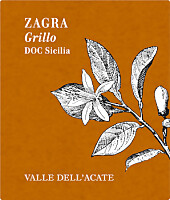
|
|
Sicilia Grillo Zagra 2021 |
|
| Valle dell'Acate (Sicily, Italy) | |
 Grillo Grillo | |
| Price: € 15.00 | Score: |
 Intense straw yellow and nuances of straw yellow, very transparent. Intense straw yellow and nuances of straw yellow, very transparent. Intense, clean, pleasing, refined and elegant, starts with hints of
apple, plum and orange blossom followed by aromas of hawthorn, chamomile,
broom, citrus fruits, pear, peach, pineapple, almond and mineral. Intense, clean, pleasing, refined and elegant, starts with hints of
apple, plum and orange blossom followed by aromas of hawthorn, chamomile,
broom, citrus fruits, pear, peach, pineapple, almond and mineral.
 Crisp attack and however balanced by alcohol, good body, intense
flavors, agreeable. Crisp attack and however balanced by alcohol, good body, intense
flavors, agreeable.
 Persistent finish with flavors of apple, plum and almond. Persistent finish with flavors of apple, plum and almond. 4 months in steel tanks, 4 months in bottle. 4 months in steel tanks, 4 months in bottle. |
|
 Pasta with fish, Fried fish, Sauteed fish, Sauteed white meat, Vegetable soups Pasta with fish, Fried fish, Sauteed fish, Sauteed white meat, Vegetable soups |
|
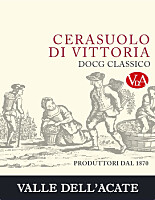
|
|
Cerasuolo di Vittoria Classico 2019 |
|
| Valle dell'Acate (Sicily, Italy) | |
 Nero d'Avola (60%), Frappato (40%) Nero d'Avola (60%), Frappato (40%) | |
| Price: € 18.00 | Score: |
 Brilliant ruby red and nuances of ruby red, moderate transparency. Brilliant ruby red and nuances of ruby red, moderate transparency. Intense, clean, pleasing and refined, starts with hints of black
cherry, plum and strawberry followed by aromas of geranium, violet,
blackberry, raspberry, carob, tobacco, chocolate, black pepper and vanilla. Intense, clean, pleasing and refined, starts with hints of black
cherry, plum and strawberry followed by aromas of geranium, violet,
blackberry, raspberry, carob, tobacco, chocolate, black pepper and vanilla.
 Properly tannic attack and however balanced by alcohol, good body,
intense flavors, agreeable. Properly tannic attack and however balanced by alcohol, good body,
intense flavors, agreeable.
 Persistent finish with flavors of black cherry, plum and strawberry. Persistent finish with flavors of black cherry, plum and strawberry. 12 months in cask, at least 9 months in bottle. 12 months in cask, at least 9 months in bottle. |
|
 Stuffed pasta with meat, Roasted meat, Broiled meat and barbecue, Stewed meat with mushrooms Stuffed pasta with meat, Roasted meat, Broiled meat and barbecue, Stewed meat with mushrooms |
|
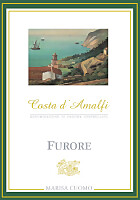
|
|
Costa d'Amalfi Furore Bianco 2021 |
|
| Marisa Cuomo (Campania, Italy) | |
 Falanghina (60%), Biancolella (40%) Falanghina (60%), Biancolella (40%) | |
| Price: € 21.00 | Score: |
 Brilliant straw yellow and nuances of straw yellow, very transparent. Brilliant straw yellow and nuances of straw yellow, very transparent. Intense, clean, pleasing and refined, starts with hints of apple,
citrus fruits and hawthorn followed by aromas of broom, pear, peach, plum,
medlar, hazelnut and almond. Intense, clean, pleasing and refined, starts with hints of apple,
citrus fruits and hawthorn followed by aromas of broom, pear, peach, plum,
medlar, hazelnut and almond.
 Crisp attack and however balanced by alcohol, good body, intense
flavors, agreeable. Crisp attack and however balanced by alcohol, good body, intense
flavors, agreeable.
 Persistent finish with flavors of apple, plum and hazelnut. Persistent finish with flavors of apple, plum and hazelnut. 4 months in steel tanks. 4 months in steel tanks. |
|
 Fried fish, Pasta with fish, Sauteed fish, Sauteed white meat, Dairy products Fried fish, Pasta with fish, Sauteed fish, Sauteed white meat, Dairy products |
|
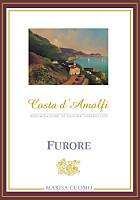
|
|
Costa d'Amalfi Furore Rosso 2021 |
|
| Marisa Cuomo (Campania, Italy) | |
 Piedirosso (50%), Aglianico (50%) Piedirosso (50%), Aglianico (50%) | |
| Price: € 21.00 | Score: |
 Intense ruby red and nuances of ruby red, little transparency. Intense ruby red and nuances of ruby red, little transparency. Intense, clean, pleasing and refined, starts with hints of plum,
blackberry and black cherry followed by aromas of violet, rose, blueberry,
pomegranate, tobacco, carob and vanilla. Intense, clean, pleasing and refined, starts with hints of plum,
blackberry and black cherry followed by aromas of violet, rose, blueberry,
pomegranate, tobacco, carob and vanilla.
 Properly tannic attack and however balanced by alcohol, good body,
intense flavors, agreeable. Properly tannic attack and however balanced by alcohol, good body,
intense flavors, agreeable.
 Persistent finish with flavors of plum, blackberry and black cherry. Persistent finish with flavors of plum, blackberry and black cherry. 6 months in barrique. 6 months in barrique. |
|
 Pasta with meat and mushrooms, Stewed meat with mushrooms, Cheese Pasta with meat and mushrooms, Stewed meat with mushrooms, Cheese |
|
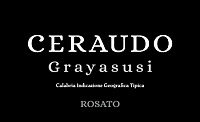
|
|
Grayasusi Etichetta Argento 2021 |
|
| Ceraudo (Calabria, Italy) | |
 Gaglioppo Gaglioppo | |
| Price: € 25.00 | Score: |
 Deep cherry pink and nuances of cherry pink, transparent. Deep cherry pink and nuances of cherry pink, transparent. Intense, clean, pleasing and refined, starts with hints of cherry,
blackberry and strawberry followed by aromas of cyclamen, rose, raspberry,
blueberry, plum, thyme and vanilla. Intense, clean, pleasing and refined, starts with hints of cherry,
blackberry and strawberry followed by aromas of cyclamen, rose, raspberry,
blueberry, plum, thyme and vanilla.
 Crisp attack and however balanced by alcohol, good body, intense
flavors, pleasing roundness. Crisp attack and however balanced by alcohol, good body, intense
flavors, pleasing roundness.
 Persistent finish with flavors of cherry, blackberry and strawberry. Persistent finish with flavors of cherry, blackberry and strawberry. 4 months in barrique. 4 months in barrique. |
|
 Stuffed pasta with meat and mushrooms, Roasted white meat, Roasted fish, Legume soups Stuffed pasta with meat and mushrooms, Roasted white meat, Roasted fish, Legume soups |
|
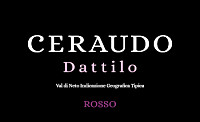
|
|
Dattilo 2018 |
|
| Ceraudo (Calabria, Italy) | |
 Gaglioppo Gaglioppo | |
| Price: € 30.00 | Score: |
 Intense ruby red and nuances of garnet red, little transparency. Intense ruby red and nuances of garnet red, little transparency. Intense, clean, pleasing, refined and elegant, starts with hints of
plum, black cherry and dried violet followed by aromas of raspberry,
blackberry, blueberry, chocolate, tobacco, leather, licorice, mace, black
pepper, vanilla and menthol. Intense, clean, pleasing, refined and elegant, starts with hints of
plum, black cherry and dried violet followed by aromas of raspberry,
blackberry, blueberry, chocolate, tobacco, leather, licorice, mace, black
pepper, vanilla and menthol.
 Tannic attack and however balanced by alcohol, full body, intense
flavors, pleasing crispness. Tannic attack and however balanced by alcohol, full body, intense
flavors, pleasing crispness.
 Persistent finish with flavors of plum, black cherry and raspberry. Persistent finish with flavors of plum, black cherry and raspberry. 24 months in cask, 12 months in bottle. 24 months in cask, 12 months in bottle. |
|
 Game, Roasted meat, Braised and stewed meat with mushrooms, Hard cheese Game, Roasted meat, Braised and stewed meat with mushrooms, Hard cheese |
|
|
||||||||
|
DiWineTaste Polls
|
| |||||||
Privacy Policy | |||||||


| Copyright © 2002-2024 Antonello Biancalana, DiWineTaste - All rights reserved |
| All rights reserved under international copyright conventions. No part of this publication and of this WEB site may be
reproduced or utilized in any form or by any means, electronic or mechanical, without permission in writing from DiWineTaste. |